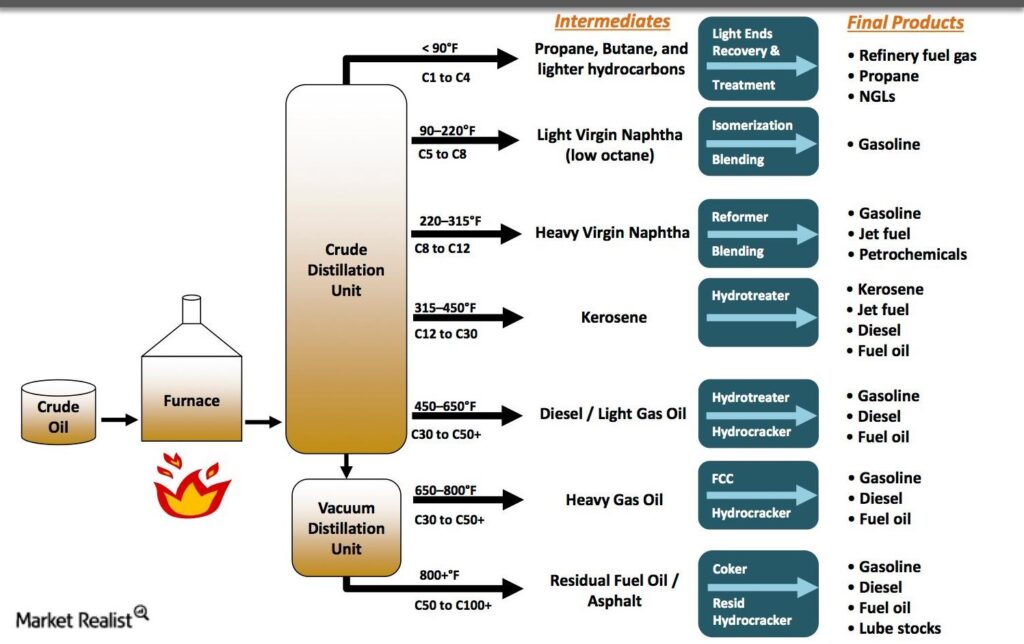FUEL OIL
Fuel oil is a byproduct obtained by distilling petroleum, either as a distillate or as leftover residue. In general, fuel oil is any type of liquid petroleum product that is utilized for heating or generating power in furnaces, boilers, or engines, except for oils that have a flash point of approximately 40 °C (104 °F) and those that are burned in cotton or wool-wick burners. Diesel is a type of fuel oil within this specific situation. Fuel oil is made up of long hydrocarbon molecules, which specifically include alkanes, cycloalkanes, and aromatics. Fuel oil, derived from crude oil, is a dense commercial fuel denser than gasoline and naphtha, and is referred to more specifically as fuel oil.
Classification of fuel oil
Fuel oil is classified into six categories, which range from 1 to 6, depending on its boiling point, composition, and intended purpose. The fuel oil number indicates both the fuel’s boiling point, which can vary from 175 to 600 °C, and its carbon chain length, which can range from 20 to 70 atoms. Greater numbers signify increased viscosity, with the thickest oil necessitating heating to facilitate flow. As the quantity of fuel rises, the cost usually goes down.
Different names for No. 1 fuel oil, No. 2 fuel oil, and No. 3 fuel oil include distillate fuel oils, diesel fuel oils, light fuel oils, gasoil, or simply distillate. For instance, No. 2 fuel oil, No. 2 distillate, and No. 2 diesel fuel oil are practically identical (with the distinction that diesel has a cetin number limit that indicates the fuel’s ignition quality). Distillate fuel oils are obtained through distillation of crude oil.
The term gas oil is used to describe the process of distillation. The oil is warmed up, turns into a vapor, and then changes back into a liquid state. It distinguishes between distillates and residual oil. Number 1 is akin to kerosene and represents the portion that evaporates immediately after gasoline. “Road diesel” is the name given to the type of diesel used by trucks and some cars, specifically No. 2. It’s equivalent to heating oil. No. 3 is a type of distillate fuel oil which is not commonly utilized. [Source needed] No. 4 fuel oil typically consists of a mixture of distillate and residual fuel oils, like No. 2 and 6, but occasionally it is solely a dense distillate. Number 4 can be categorized as diesel, distillate, or residual fuel oil. Residual fuel oils or heavy fuel oils are known as No. 5 fuel oil and No. 6 fuel oil. Because No. 6 is produced in greater quantities than No. 5, heavy fuel oil and residual fuel oil are sometimes used interchangeably with No. 6. They are the remnants of crude oil left after the extraction of gasoline and distillate fuel oils through distillation. No. 5 fuel oil consists of No. 6 (approximately 75-80%) blended with No. 2. Number 6 might include a slight quantity of Number 2 to ensure it complies with the requirements.
Residual fuel oils are referred to as light when combined with distillate fuel oil, and distillate fuel oils are referred to as heavy when combined with residual fuel oil. For instance, heavy gas oil is a type of distillate that includes residual fuel oil. The easy access to extremely heavy fuel oils is frequently a result of the effective catalytic cracking process, which extracts more valuable components and leaves behind a dense residue.
Applications of fuel oil
Oil serves multiple purposes; it warms homes and workplaces, and powers trucks, ships, and certain vehicles. Diesel produces a small quantity of electricity, however, it is costlier and more harmful to the environment compared to natural gas. It is commonly utilized as an alternative fuel for peaking power plants if the natural gas supply is cut off, or as the primary fuel for small electrical generators. In Europe, diesel is mainly used in cars (approximately 40%), SUVs (around 90%), and trucks. The demand for heating oil in the home heating market has dropped because of the extensive use of natural gas. Nevertheless, it is prevalent in certain regions like the Northeastern United States.
The process of creating fuel oil
Fuel oil is acquired through the distillation of crude oil. At the start of the distillation process, compounds like propane, naphtha, gasoline, and jet fuel are separated into individual molecules due to their low boiling points. Diesel and lubricants, which are heavier products, have lower volatility and distill more slowly. Bunker fuel and fuel for steam engines and ships are the final result of this process. Certainly, there are also heavier compounds like bitumen and asphalt that are left behind after the procedure. Different oil cuts are visible in the image below.
